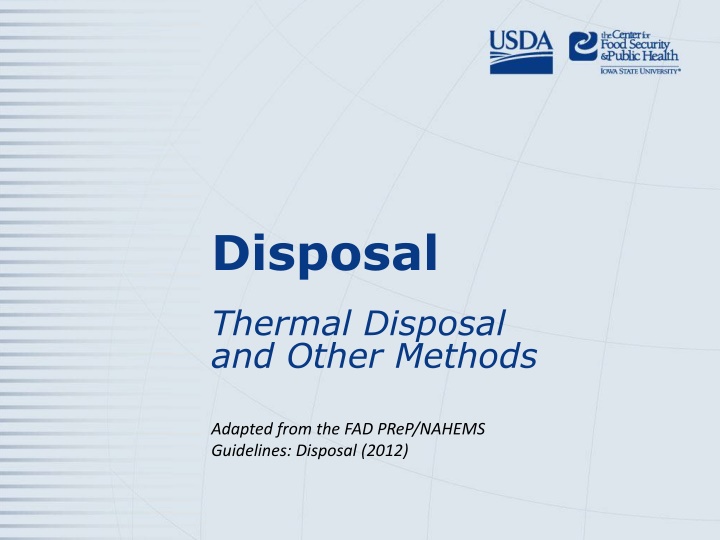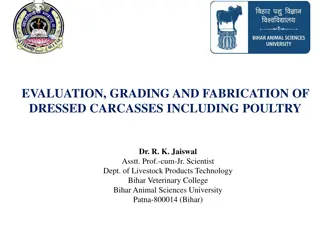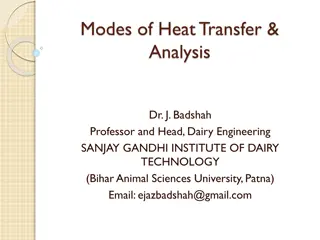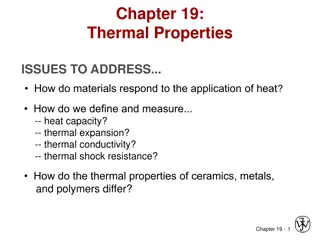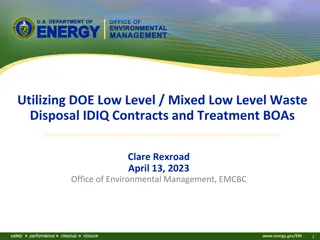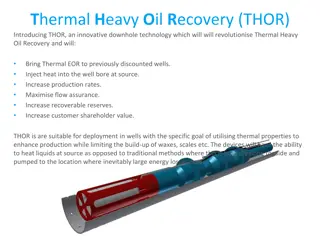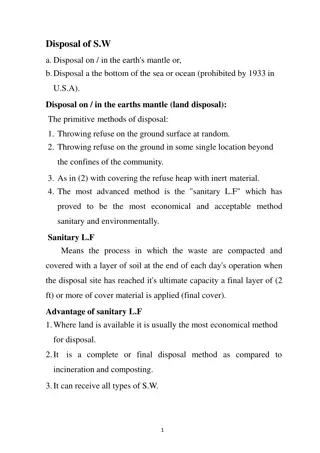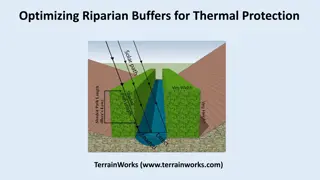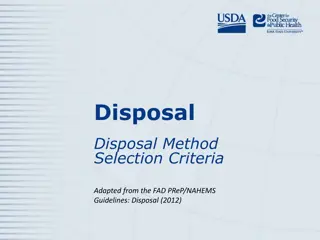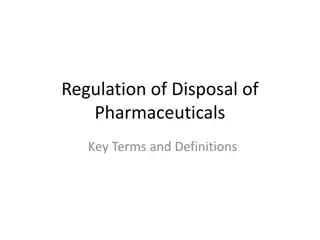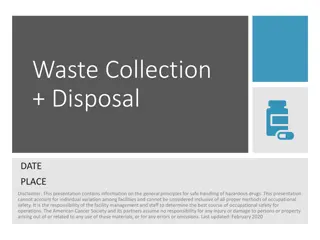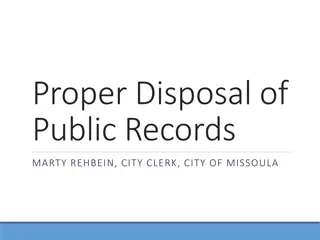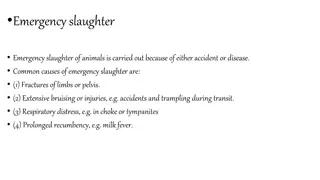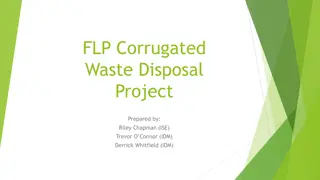Thermal Disposal Methods for Animal Carcasses: Guidelines and Best Practices
Explore thermal disposal methods adapted from the FAD PReP/NAHEMS Guidelines for effectively managing animal carcasses. Learn about high-temperature combustion, fixed-facility incineration, open-air burning risks, and air-curtain incineration techniques. These methods vary in efficiency, environmental impact, and safety considerations for proper disposal of animal remains.
Download Presentation

Please find below an Image/Link to download the presentation.
The content on the website is provided AS IS for your information and personal use only. It may not be sold, licensed, or shared on other websites without obtaining consent from the author.If you encounter any issues during the download, it is possible that the publisher has removed the file from their server.
You are allowed to download the files provided on this website for personal or commercial use, subject to the condition that they are used lawfully. All files are the property of their respective owners.
The content on the website is provided AS IS for your information and personal use only. It may not be sold, licensed, or shared on other websites without obtaining consent from the author.
E N D
Presentation Transcript
Disposal Thermal Disposal and Other Methods Adapted from the FAD PReP/NAHEMS Guidelines: Disposal (2012)
Thermal Disposal Methods FAD PReP/NAHEMS Guidelines: Disposal - Thermal Disposal and Other Methods USDA APHIS and CFSPH
Thermal Methods Overview High-temperature combustion Diesel fuel, propane, furnace, waste oils Do NOT use gasoline Transmissible Spongiform Encephalopathy (TSE) agents rendered non-infectious by Minimum 1560oF for 15 minutes Higher temperatures (1830oF) ideal FAD PReP/NAHEMS Guidelines: Disposal - Thermal Disposal and Other Methods USDA APHIS and CFSPH
Fixed-Facility Incineration Contained environment Fueled by diesel, natural gas, propane Emissions controlled Highly efficient Little residue (ash) High fat carcasses burn more quickly FAD PReP/NAHEMS Guidelines: Disposal - Thermal Disposal and Other Methods USDA APHIS and CFSPH
Fixed-Facility Incineration On-site incinerators Large animal production facilities, vet schools/diagnostic laboratories, etc. Limited continuous capacity Other waste incineration facilities Municipal solid waste facilities, etc. Unlikely to accept animal carcasses Batch feed, and low heating value FAD PReP/NAHEMS Guidelines: Disposal - Thermal Disposal and Other Methods USDA APHIS and CFSPH
Open-Air Burning History of used Uncontrolled Fuel and air inputs not controlled Incomplete/smoky, low-temp combustion Lengthy process May be prohibited by States FAD PReP/NAHEMS Guidelines: Disposal - Thermal Disposal and Other Methods USDA APHIS and CFSPH
Open-Air Burning Negative public perception Use isolated areas Use trained personnel Involve fire authorities Open fields, pyres Combustible materials Hay, straw, dry timbers Ash disposal / pathogen escape FAD PReP/NAHEMS Guidelines: Disposal - Thermal Disposal and Other Methods USDA APHIS and CFSPH
Air-Curtain Incineration Combination of forced air and fuel used to burn carcasses or waste Increased temperature Accelerated combustion (up to 6x faster than open-air burning) Fan/manifold delivers high-velocity air into metal box or burn pit Mobile or fixed technology FAD PReP/NAHEMS Guidelines: Disposal - Thermal Disposal and Other Methods USDA APHIS and CFSPH
Air-Curtain Incineration Systems vary in size and speed of throughput Can produce noise Require fuel Dry wood Coal Diesel (fire and fan) Produces ash FAD PReP/NAHEMS Guidelines: Disposal - Thermal Disposal and Other Methods USDA APHIS and CFSPH
Other Disposal Procedures FAD PReP/NAHEMS Guidelines: Disposal - Thermal Disposal and Other Methods USDA APHIS and CFSPH
Alkaline Hydrolysis Process High temperatures (steam heat), pressure, and pH (strong base) Solid by-products and sterile aqueous solution produced On-site or fixed location Low carcass capacity, but effective against pathogens such as TSEs FAD PReP/NAHEMS Guidelines: Disposal - Thermal Disposal and Other Methods USDA APHIS and CFSPH
Anaerobic Digestion Lactic acid fermentation Ground carcasses mixed with lactic acid bacteria and fermentable carbohydrates Produces water, methane, CO2 Does not inactivate prions Process takes 7-10 days Produces odors, store in sealed and controlled-vented containers FAD PReP/NAHEMS Guidelines: Disposal - Thermal Disposal and Other Methods USDA APHIS and CFSPH
Gasification Emerging thermal technology Slow heating occurs in containers Gasification and combustion chambers Batch or continuous process Converts carcasses into gasses and ash Carbon dioxide, carbon monoxide, methane Process takes up to 12 hours FAD PReP/NAHEMS Guidelines: Disposal - Thermal Disposal and Other Methods USDA APHIS and CFSPH
Plasma Vitrification Electrically generated heat used to ionize compressed air High temperatures (7000 C +) Water is vaporized Reduces biomass by 97% Converts carcasses to rock-like solid residue Resistant to leaching FAD PReP/NAHEMS Guidelines: Disposal - Thermal Disposal and Other Methods USDA APHIS and CFSPH
For More Information FAD PReP/NAHEMS Guidelines & SOP: Disposal (2012) http://www.aphis.usda.gov/animal_ health/emergency_management/ Disposal web-based training module http://naherc.sws.iastate.edu/ FAD PReP/NAHEMS Guidelines: Disposal - Thermal Disposal and Other Methods USDA APHIS and CFSPH
Guidelines Content Authors Rene Dewell, DVM, MS (CFSPH) Tom Glanville, PhD (Iowa State University) Significant contributions to the content were provided by USDA APHIS VS: Lori P. Miller, PE Darrel K. Styles, DVM, PhD FAD PReP/NAHEMS Guidelines: Disposal - Thermal Disposal and Other Methods USDA APHIS and CFSPH
Acknowledgments Development of this presentation was by the Center for Food Security and Public Health at Iowa State University through funding from the USDA APHIS Veterinary Services PPT Author: Kerry Leedom Larson, DVM, MPH, PhD, DACVPM Reviewers: Janice Mogan, DVM; Rene Dewell DVM, MS
